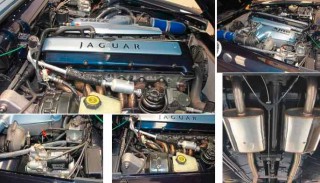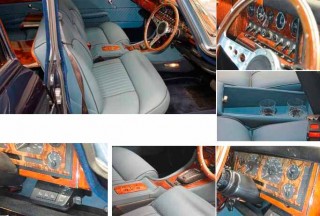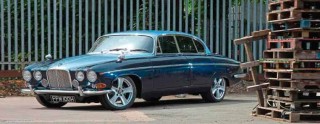MODIFIED SUPERCHARGED 1970 JAGUAR 420G / MKX / MK10 Supercharged 420G We drive a 420G powered by an XJR’s supercharged 4.0-litre straight-six engine. Discover how Bespoke Auto Developments carried out this adventurous modification.
Modernised Classics are often difficult to visualise, and can sometimes go disastrously wrong. Your perspective partly depends on how the original car is regarded and whether updating its looks and mechanical components is going to appeal. While Jaguars such as the iconic E-type and the emerging classics – including the XJS – shouldn’t be extensively fettled, what about the 420G?

The Mk X saloon first appeared in 1961 and although it was the largest model in production throughout its ten-year lifespan, it was no slouch. Initially powered by the E-type’s 3.8-litre XK engine, which boasted a top speed of 120mph, the car was faster and cheaper than a Rolls-Royce Silver Cloud III. In 1966, the engine was stretched to 4.2-litres and the car renamed 420G, but it retained the same 265bhp power output, shaving 0.4 seconds off its 0-60mph time (down from 10.8 seconds for the 3.8-litre to 10.4 seconds) and adding 2.5mph to its top speed.
Throughout their lifetime, both the Mk X and 420G gained a favourable reputation as large, high-performance, luxury saloons that boasted such-modern-day equipment as servo-assisted all-round disc brakes, air-conditioning and electric windows. They rivalled Rolls-Royce with sofa-sized seating for five people and ample legroom in the rear, plus an enormous boot, and had twin ten-gallon petrol tanks mounted inside the rear wings to provide a range of nearly 300 miles.

More than 25,000 Mk X and 420G saloons were produced, but today they appear to be overshadowed by the sportier Mk 2 and XJ6 Series 1. According to the website www.howmanyleft.co.uk, during 2017 there were less than 50 Mk X and 420G saloons taxed or SORN’d in the UK. So, maybe now is the time to prove its ability and test the water with some modifications.
Along with completing restorations, Cheshire-based Bespoke Auto Developments (or BAD, as it likes to be known) has been experimenting with engine transplants for more than ten years. The company dabbled with shoehorning a batch of ex-MG Mustang V8s into Jensen Interceptors, but that was shelved when the demand for standard examples became more profitable.
The decision to buy, restore and modify a 420G started after seeing a photograph from the USA of a similar car with X300 XJR mechanical components. Everyone at BAD agreed they could do a better job, as Andrew Wilson explains, “It looked great from the pictures, but was a little too cobbled together in the detail of the engine bay. So, we decided to put our own spin on the concept and build a car where all details and conveniences were professionally completed and all the XJR running gear was used, as well as some of the ancillaries.”

The X300 and 420G share some common features, the most important being a similar wheelbase and a monocoque design with front and rear subframes. The team at BAD realised it could transplant the X300 subframes into the 420G, and started with an abandoned 1970 420G from Lincolnshire and a taxed-and- tested 1996 X300 XJR from Sheffield.
CLOCKWISE FROM FAR LEFT: Anti-lock braking system from the XJR, including the ABS pump and all the brakes, has been transplanted into the 420G Modern X300 brake servo is positioned in-line. Stainless-steel exhaust manifold is BAD’s own design 4.0-litre supercharged straight-six from the X300 XJR is a neat installation.
Andrew still winces when he recalls breaking the news to the owner of the XJR that their car was going to be stripped. The entire project from start to finish took two years, on and off, in between customers’ work being completed. The stripdown of the XJR had to be carefully completed to make sure donor components could be reused. As Andrew recalls, “The wiring loom was meticulously labelled and removed from the XJR, as were all components for the air-con system, dashboard gauges, clocks and controls.”
The 420G’s bodywork was then stripped, repaired where corrosion had settled in, and modified to fit the XJR donor components. They blasted the complete bare shell, seam sealed all panels and etch-primed it ready for paint. Says Andrew, “We took the decision to first fit everything back into the car after the initial fabrication work and virtually build the whole car to a point where it was a running vehicle, before we stripped it ready for paint and a final fit of everything.”

Trial-fitting before the final respray enabled BAD to work through several electrical problems. “A lot of time was taken on this part of the build and left us scratching our heads on many occasions,” Andrew says. “Martin Rickman, an old-school auto electrician, saved the day and was able to get what looked like a rats’ nest of wires into a new wiring loom with all components functioning as they should. The only failure was having the ECU security bypassed for the immobiliser as this was preventing a live to the starter motor, but, once sorted, the car started without hesitation.”
TOP: Wooden dashboard is retained, but original speedo has been replaced with XJR instruments. The panel from the X300 replaces the main gauges for the 420G and communicates with all relevant sensors and senders.
ABOVE: Reupholstered interior includes a central armrest in the rear and storage for drinks glasses.
RIGHT: Reupholstered interior retains the 420G’s sofa-sized seats.
BELOWLEFT TO RIGHT: Original 420G switch panel has been reused. Two of the instruments were replaced with tweeters for the stereo 420G’s electric windows are reused, but with a new switch panel. X300’s J-gate gearlever is fitted Cruise control switch panel is from the X300.
The hard work seems to have paid off when you look over the finished car. From the outside, the two-tone Opel Midnight Blue and Jaguar Opalescent Silver Blue paintwork is undoubtedly more modern than the duller Sixties and Seventies Sable Brown that this 420G originally sported. The tinted glass also updates its appearance, although perhaps the most obvious addition is the new wheels, which are 18in BMWX5 alloys, which conveniently have the correct PCD (pitch circle diameter), along with a suitable offset, so spacers are not required.
Such modern touches do not look out of place with the plethora of standard brightwork that adorns the front of the 420G, all of which have been re-chromed. The only minor modification at the front end is a lower spoiler, fabricated to protect the underside of the engine’s radiator and the air-con’s condenser.

Inside, the 420G’s seating has been reupholstered in matching blue leather. A central armrest is incorporated into the rear seat back, and a pull-up drinks cabinet is sunk into the middle of the seat base. Traditional features in the rear have been retained, such as foldable picnic tables on the backs of the front seats and hinged quarterlights for extra airflow.
Talking of airflow, there are vacuum-operated air intake flaps in front of the windscreen. “Due to the increased vacuum from the XJR engine, the flaps shut when accelerating hard and open again when you let your foot off the throttle pedal,” explains Andrew.
Sitting in the armchair-sized driver’s seat, there are some familiar traits of the 420G. The steering column and single stalk switch have been reused; the walnut dashboard is also present, but the main instruments have been changed for a complete instrument cluster from the X300. Consequently, two of the original gauges in the centre of the dashboard have been replaced with stereo tweeters – and there’s a retro-looking stereo mounted in the centre console that offers modern entertainment features, including a CD player, plus USB and iPod connectivity.

The 4.0-litre straight-six supercharged AJ16 engine fires into life on the button and provides a throaty rumble on tickover, courtesy of BAD’s own design of six-branch stainless-steel tubular exhaust manifold, which is connected to a twin silencer system. The 420G’s BorgWarner DG automatic transmission (they also had a four-speed manual Moss gearbox with overdrive) has been replaced with the X300 XJR’s five-speed automatic gearbox and a J-gate lever mounted onto the centre tunnel. It’s straightforward to operate and, unlike older automatic gearboxes, there are no clunks or jolts when selecting drive or reverse. Instead, it’s smooth, and the car neither lurches nor leaves the driver fighting with the brake pedal to keep the car stationary.
On the move, the throttle pedal doesn’t need much pressure to drive sedately and smoothly, but press hard and the engine responds. With an estimated two tonnes or more to propel, the 322bhp that the XJR engine has to offer at the flywheel clearly has to work hard to impress. However, the refined ride quality does mean acceleration can be deceptive, so the car begins to move along at a faster pace than expected. In the X300, this supercharged engine can reach 60mph from standing in 5.9 seconds. It’s doubtful the same time can be achieved in the 420G, due to extra weight and poorer aerodynamics, but it’s faster than a standard engine and a lot easier to drive.
BELOW FROM TOP: The front subframe, brakes and suspension are from the X300 X300 radiator sat a little too low in the engine bay; BAD fabricated a spoiler to protect its underside Cable between the umbrella handbrake and rear wheels needed carefully routing underneath the vehicle
BELOW: Twin underslung exhaust system produces a throaty tune from the supercharged six-cylinder engine.

The only aspect of the 420G’s steering, suspension and brakes to be reused is the steering column, so handling, stopping power and ride quality have all been updated. The ride quality is refined and not too firm, despite 40-profile tyres all round. The large steel body rolls a little under cornering, and the wood-rimmed steering wheel feels a little notchy; unlike a padded steering wheel it offers no damping of feedback. The brakes are responsive, but not too aggressive, and there is the added bonus of ABS, should you need it.
BAD had to modify the 420G’s bodywork to fit the XJR front and rear subframes, particularly the front inner wheelarches and chassis rails. At the rear, the subframe mounting points were needed from the XJR, so it cut out the rear floor section of the donor vehicle and fitted it to the 420G.
The subframes and their associated components remain standard, albeit refurbished before being fitted. The engine has covered 102,000 miles, so it was checked and serviced, although it didn’t require a bottom-end rebuild (the cylinder head was stripped and gas-flowed).
Transplanting the mechanical components of an X300 XJR into a 420G has clearly been an ambitious project, and it seems to have paid off. BAD has tried to use everything possible from the donor X300, including the air-conditioning, central locking and cruise control. However, it had to concede when it came to the electric window regulators, instead retaining the 420G’s motors and mechanisms, but did make a custom switch-panel to operate them, which is mounted in the centre console. Easy to operate, the door glass moves surprisingly swiftly for an old design of window regulator. Other components from the 420G are the heater matrix, fan and ducting.
This modern-looking XJR-powered 420G is now for sale with a price tag of £57,750. Most standard 420G and Mk X saloons appear to be advertised at between £15,000 and £30,000; what you’re paying for here, of course, is a transplant project with restored bodywork. It should appeal to someone who likes the 420G shape, but wants an updated appearance and specification. It’s not going to be liked by everyone, but it demonstrates the ingenuity adopted by BAD in daring to be different.
Thanks to: Bespoke Auto Developments (01260 221723; bespokeautodevelopments.co.uk)





